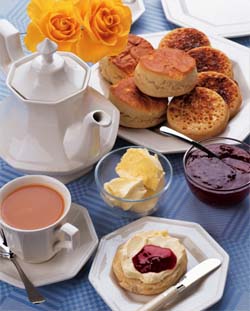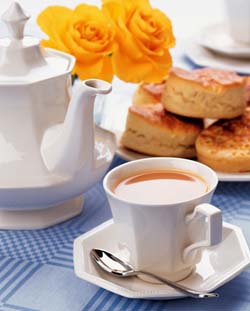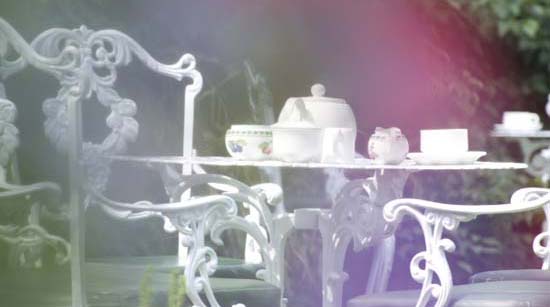It's Time for Tea
by Dawn Copeman
 Nothing is considered as quintessentially English as tea. Okay, so we can't grow it here -- although a chap in Cornwall is trying to do just that -- but we long ago adopted it as our national drink. And although the younger generation (myself included) have become somewhat Americanized and tend to drink coffee, in time of a crisis or mid-afternoon when one is feeling a bit peckish, nothing else will do but a nice cup of tea.
Nothing is considered as quintessentially English as tea. Okay, so we can't grow it here -- although a chap in Cornwall is trying to do just that -- but we long ago adopted it as our national drink. And although the younger generation (myself included) have become somewhat Americanized and tend to drink coffee, in time of a crisis or mid-afternoon when one is feeling a bit peckish, nothing else will do but a nice cup of tea.
But tea time in Britain means more than drinking a cup of tea. Teatime is an actual meal and depending upon where in the country you find yourself, this meal could be anything from a scone, to a few light sandwiches and cakes, to a full roast dinner.
I guess I'd better explain. There three kinds of teatime in Britain: Afternoon Tea, Cream Tea and High Tea.
Afternoon Tea
Afternoon Tea is traditionally served between four and five in the afternoon -- hence the name. Many people believe that this tradition was first started in 1841 by Anna Maria Stanhope, the seventh Duchess of Bedford. At that time, and in fact right up until the early decades of the 20th century, luncheon was served at twelve noon but dinner was not served until 8:00 or even 9:00 in the evening. The Duchess, so the story goes, complained of a 'sinking' feeling in the middle of the afternoon and asked for some tea and a few slices of bread and butter to be served to her in her private drawing room; the Blue Room at Woburn Abbey.
Whether this is true or not, at some point this trend for eating in the afternoon became more widespread and popular and soon ladies across the land who were 'at home' would dress elaborately in their finest dresses and visit each other's houses to partake of afternoon tea.
 In addition to the slices of bread and butter, one would offer thin cucumber sandwiches, or salmon sandwiches (with the crusts removed, naturally) as well as cakes, pastries, scones with cream, and of course a Victoria sponge cake. To be able to bake a light and moist Victoria sponge was the true test of one's cook. In addition to the slices of bread and butter, one would offer thin cucumber sandwiches, or salmon sandwiches (with the crusts removed, naturally) as well as cakes, pastries, scones with cream, and of course a Victoria sponge cake. To be able to bake a light and moist Victoria sponge was the true test of one's cook.
The tea, India or China or in many houses, both, would be served in silver tea pots and poured into fine china cups. Etiquette books contained whole chapters on the etiquette of Afternoon Tea and the tea dress was created to be worn at such social gatherings. Afternoon Tea, was, it should be noted, a social occasion in which only the upper class participated.
That is, until 1864, when the Aerated Bread Company opened a tea shop for middle-class women. Soon Fortnum and Masons, The Ritz, and Brown's Hotel had all opened tea rooms, and it became quite fashionable for women to visit these tea rooms in the afternoon. These tea rooms were, by the way, the only place where a lady could meet her friends without a chaperone without damaging her reputation.
During the First World War, due to food rationing, ladies stopped taking afternoon tea 'at home,' and even when the war ended, the tradition was not taken up again. If one got peckish mid-afternoon, a cup of tea and a biscuit would suffice. If one wanted a full afternoon tea, one went out to a hotel. And it is only in hotels and tea rooms that one can enjoy a traditional afternoon tea today. The prices might seem a little steep, but remember, this style of afternoon tea was always intended for the upper classes and that is what the price reflects.
- Tea at the Ritz costs £34.00 per person
- At Fortnum and Masons' St James' Tearoom it costs between £18.50 and £21.50
- At Brown's Hotel English Tea Room it costs £27.50
You still get choice of tea, and in some cases the tea list is a long as a wine list, but don't feel embarrassed if you don't know the difference; most Brits don't either!
However, this type of Afternoon Tea is very much for the upper classes and the tourists. In most British homes, afternoon tea consists of a cup of tea and a light snack, be that a biscuit, a piece of cake, hot buttered toast or crumpets.
Now, crumpets are hard to describe. They are round and about the same size as English muffin, but they are not English muffins. They are made of a soft, bread-like dough and are peppered all over the top-side with holes. These holes allow the butter to melt all the way through the crumpet, which tastes absolutely fantastic. A crumpet must be toasted to be eaten. Eating a raw crumpet is unheard of -- I guess it would taste like eating raw dough -- but a hot, buttered crumpet is a true delight and the perfect accompaniment to a cup of tea. [Editor's note: It tastes a bit like eating a raw English muffin, only heavier.]
Cream Tea
 The cream tea is similar to the afternoon tea, but without the sandwiches and other cakes. The cream tea is similar to the afternoon tea, but without the sandwiches and other cakes.
The most famous cream tea is the Devonshire Cream Tea. According to local legend, the Devonshire Cream Tea originates from Tavistock, or more precisely Tavistock Abbey. This Benedictine Abbey was plundered by Vikings in the 11th Century and then rebuilt. The monks fed the laborers who were rebuilding it with a calorie-rich food consisting of bread, clotted cream and strawberry preserve. Over time the bread became scones and thus the cream tea was born. However, the counties of Somerset, Cornwall and Sussex will contest this legend; they all offer cream teas too!
A cream tea consists of freshly baked fruit scones, some clotted cream, butter and strawberry jam served with a large pot of tea. The idea is you pour your tea -- no choice this time, just whatever is in the pot -- and then construct your scone to eat with your tea. Butter the scone, add some jam and then add some clotted cream to taste. It tastes delicious but can be a bit messy. [Editor's note: You do not, like this ignorant American tourist (and I know I'm not alone here), put the clotted cream in your tea.]
Cream Teas are advertised everywhere in summer, but at other times of year you will need to make enquiries at tea shops and hotels.
High Tea
Some hotels advertise that they serve "high tea" and then go on to describe a rich and sumptuous afternoon tea. Whilst high tea sounds very, very grand, it is in fact, a working class meal. High Tea is actually dinner.
When tea was first introduced into Britain it was an expensive luxury, but over time as prices fell it became a staple in the diet of the poor and tea accompanied every meal.
Prior to the industrial revolution, when most people worked in agriculture, the workers would come home at lunch time and eat their main meal then. After the industrial revolution, the working classes could not come home at lunch time and so the main meal of the day took place in the late afternoon, or early evening -- the same time as the afternoon tea of the rich. This meal became known as teatime. It was a High Tea if it contained hot and filling foods and just Tea if it comprised mainly of breads and cold cuts. A High Tea consisted of whatever was available -- bacon, eggs, meats, stew -- there were no hard and fast social rules for this meal except that it would always be accompanied by copious amounts of tea.
Even today the working classes -- especially in the north -- have their main meal at teatime. When I was growing up the three meals of the day were known as breakfast, dinner and tea -- a throwback to the pre-industrial meal times -- and tea was always served at 5pm.
In the south, however, and amongst the middle classes across the land, these same meals are breakfast, lunch and dinner, with dinner being served at around 7pm. Teatime does exist as a meal for the children and is served at 5pm. (Yet another example of the famous British North - South divide I suppose.) Having said that, you just try and get a meal in a restaurant at 5pm -- it's almost impossible! Restaurants serve dinner, not tea! And they only serve dinner at dinner time!
So next time you come to Britain, I hope you'll enjoy some tea. In fact, now that you know what they all are, why not try all three?

More Information:
We regret that we no longer have the resources to maintain up-to-date links and/or hours and pricing details for the various sites and attractions listed on this website. For more information about the location(s) listed above, please use your favorite search engine or visit Wikipedia.
Dawn Copeman is a freelance writer and commercial writer who has had more than 100 articles published on travel, history, cookery, health and writing. She currently lives in Lincolnshire, where she is
working on her first fiction book. She started her career as a freelance
writer in 2004 and has been a contributing editor for several publications, including TimeTravel-Britain.com and Writing-World.com .
Article © 2006 Dawn Copeman
Photos courtesy of Britainonview.com
|
